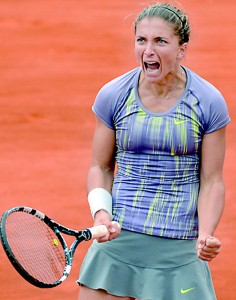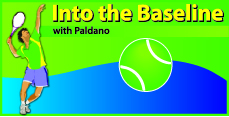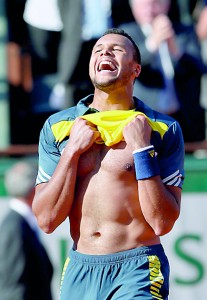Thrills of Paris clay court tennis
‘If you are wrestling a Gorilla, you cannot stop when you are tired. You can only stop when the Gorilla is tired’. This is the challenge in fitness for sport. The rain disrupted 2013 French Open enacted this logic, as we saw mega drama a good few times, making ‘should-be-winners’ into losers on famed clay courts.
Grueling long matches
In two long five set matches, Gael Monfils of France and Nicolas Almagro of Spain lost to Tommy Robredo in successive rounds. These

Sara Errani of Italy - " singles Semi finals in Paris and World's No.1, in doubles.
gave the 32nd seed and veteran Spaniard Robredo a place in the last eight. On his way up the draw, he played 3 five set matches, each, closing on to 4 hours. Up to the quarter finals run, he could be named as the man who did not stop until the Gorilla did.
Tommy Haas of Germany also won against the super tall John Isner of USA in a 4-hour, 17-minute match, that is nearly as long as 3 Football matches. Haas too made it to the last eight.
Some of the women’s matches too went noticeably long. The significant one was that of 5th seed Sara Errani of Italy against the 19 year old Spaniard Suarez Navarro. Not only was it long but had a tempo of a fire trail. Shot after shot until eventually one let go the Gorilla, the match thrilled the audiences.
The rain-disturbed schedule, forced players to wait long hours, without the rest day between matches and also to play on wet, slow courts. Sixth seed and former French Open winner, China’s Li Na, went down early, on that count to unseeded Spaniard Medina Garriques.
Artistry resurfaced
Today’s popular concrete based hard courts have polarised Tennis into ground strokes which means, to play predominantly from the baseline. Some players play 80% of the time on Hard courts. The European clay season opened the game to variety. Players are using slice to approach the net; there were passing shots; spin serves; lot of touch drop shots; and single-handed backhand too. The variety of the game blossomed again and Tennis became entertaining in the European clay this year. The artistry attracted spectators.
Jo-Wilfred Tsonga in the second week
Frenchman Tsonga has an impressive record but is short of a grand slam title. He came to the limelight in the Australian Open some years ago. Tsonga has always been entertaining to watch and now he is also effective. As I write this, he is yet to drop a set in the French Open. Seeded 6th, he won against underperforming Roger Federer easily and entered the semi-finals. It is uncommon to describe Federer in this manner. The one time king does not move well now. All these gave Tsonga the best chance to go past him. Tsonga used the net play very effectively. Is he a favorite? Anyone in the semi finals of French Open is a favorite. Tsonga is certainly looking very good. But then we have Ferrer who has got to the last four as predicted. Tommy Robredo went down to Ferrer unable to do yet another 5 set Gorilla hat trick. The upper half has Novak Djokovich, Stanislaus Wawrinka, Tommy Hass and the Spanish special Nadal. They are all very good on clay. Asia’s only hope, Japan’s Nishikori went down gracefully to Nadal in the Quarters to Nadal.
French Open. Seeded 6th, he won against underperforming Roger Federer easily and entered the semi-finals. It is uncommon to describe Federer in this manner. The one time king does not move well now. All these gave Tsonga the best chance to go past him. Tsonga used the net play very effectively. Is he a favorite? Anyone in the semi finals of French Open is a favorite. Tsonga is certainly looking very good. But then we have Ferrer who has got to the last four as predicted. Tommy Robredo went down to Ferrer unable to do yet another 5 set Gorilla hat trick. The upper half has Novak Djokovich, Stanislaus Wawrinka, Tommy Hass and the Spanish special Nadal. They are all very good on clay. Asia’s only hope, Japan’s Nishikori went down gracefully to Nadal in the Quarters to Nadal.
Dark horse

Jo Wilfred Tsonga - " Coming of age?"
Sara Errani will play Serena Williams in the semi-finals. Errani has been in the circuit since ‘98. It is her all court play and the ability to win points at net that made her the Dark Horse. But then she will have to get past Serena first to play the title round. A noticeable factor in Women’s Tennis is their net play. There has been a significant increase and they played at net in a variety of ways. There were some serve and volley as before.
Title winning factor
Some players lose up to 16 kilos in body weight in this tournament. After the round of 16 all players have equal skills to win. When it is so, ‘Physical-capacity’ will be the deciding factor on clay. With 4 to 10 shot rallies as average, three and half hours as average time and having to play 6 matches to be in the semi-finals, it is body for performing and nerves for recovery, that take the toll. The recovery has to keep up with energy expenditure. Three critical skill factors are dependent on the physical-capacity of a player. They are body-speed, power and reaction. Body-speed is sensory neuromuscular efficiency. As far as I know, less than 1% knows of it and addresses this factor. Less than 15% understand their own physical need and peaking systems. I do not blame them because these unfortunately are not the same for everyone. That is the catch when it comes to physical-capacity!
If you are in Sport remember the ‘Gorilla’ story for fitness!
- georgepaldano@yahoo.com
Follow @timesonlinelk
comments powered by Disqus


